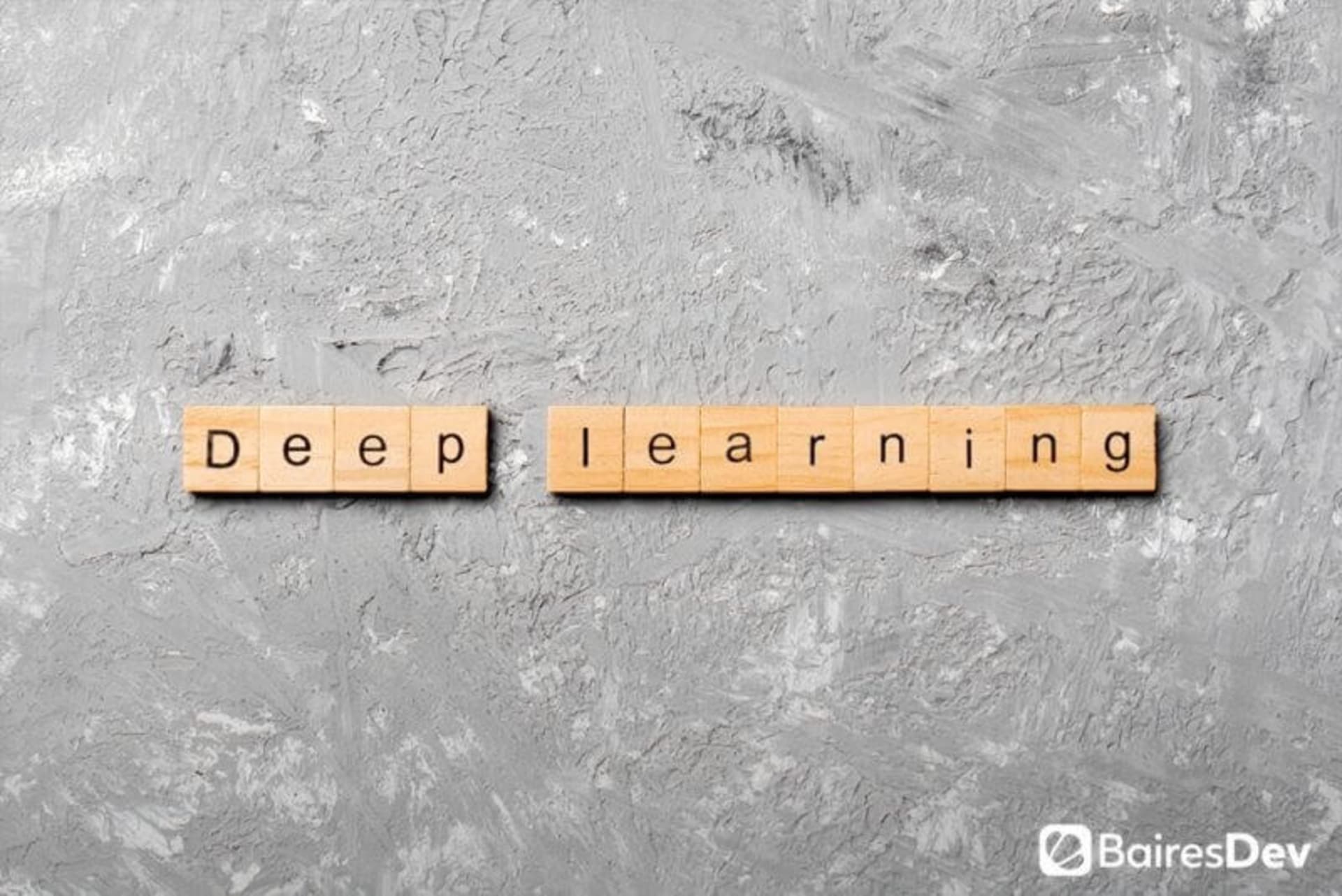Deep Learning Development
Our deep learning development services already power dozens of active engagements. We typically land our teams within 2 weeks, so you can start shipping top-quality software, fast.
500+ companies rely on our top 1% tech talent.
Deep Learning Development Services We Provide
Deep Learning Model Development
Image and speech recognition, object detection, and predictive analytics are just some of the applications of deep learning we use every day. A subset of machine learning, the technology helps us solve complex problems and drives innovation. The models can learn and improve from data, offering unparalleled insights and automation to improve inefficiencies.
Using frameworks and tools like TensorFlow, PyTorch, and Keras, we build scalable and high-performance deep learning models. Our solutions range from chatbots and virtual assistants to personalized recommendation engines.
Computer Vision Development
Transform visual data into actionable insights. Enhance automation, boost security, and improve data analysis through image and video processing.
Leveraging tools like OpenCV and YOLO, we develop computer vision applications that can recognize, classify, and interpret visual information. We create solutions spanning diverse industry sectors, from healthcare and retail to finance and automotive.
Natural Language Processing
Enabling machines to interpret human language, NLP improves user interactions, automates content analysis, and helps your team derive actionable insights from text data.
From sentiment analysis to language translation, we build NLP models capable of understanding and generating human language to perform versatile tasks. We use technologies like spaCy, NLTK, and BERT to create solutions that enhance customer experiences, improve efficiency, and increase accessibility.
Deep Learning Application Development
Equip your software with intelligent, AI-powered functionalities. Deep learning app development powers smarter decision-making and enhances user experiences with advanced neural networks that seamlessly integrate into applications.
We use frameworks like TensorFlow Lite, ONNX, and Core ML to develop secure and high-performance deep learning applications for mobile, web, and desktop platforms.
Deep Learning Integration
Integrate AI-driven features seamlessly into your workflows. Deep learning integration improves your existing systems by increasing efficiency, enhancing intelligence, and optimizing operations.
Our integration services ensure compatibility and scalability with minimal disruptions to your workflows. We leverage APIs and libraries like TensorFlow Serving, TorchServe, and Apache MXNet to integrate deep learning models into your existing infrastructure.
Predictive Analytics
Leverage predictive analytics to forecast future trends and outcomes. This enables data-driven decision-making that can boost business.
We help you transform historical data into actionable insights to improve strategic planning and operational efficiency. Tools like Scikit-learn, TensorFlow, and H2O.ai allow us to develop predictive models tailored to your business needs.
Rolls Royce case study

Key Things to Know About Deep Learning
Best Practices for Deep Learning
We use data augmentation techniques, normalization, and class imbalance handling to prepare the data for your deep learning model.
Starting with pre-trained models for better performance, we design models in a modular way and leverage regularization techniques.
We leverage tools like Hyperopt, Optuna, or Ray Tune for more efficient hyperparameter optimization. We also implement learning rate schedules and experiment with different batch sizes.
Our training strategies include mixed precision and distributed training. We also regularly save model checkpoints to avoid losing progress and ensure recovery from failures.
Through visualization tools, automated alerts, and comprehensive logging, we ensure thorough monitoring.
We leverage cloud platforms like AWS, GCP, or Azure for flexible and scalable resource allocation. We also optimize GPU utilization to effectively balance workloads and minimize idle time. Additionally, we implement strategies to control costs, such as budget alerts.
Our deployment strategies include containerization (with Docker or Kubernetes), continuous integration/continuous deployment (CI/CD) pipelines, and A/B testing.
We continuously monitor performance by leveraging metrics like accuracy, latency, and F1-score. We also implement mechanisms to detect model degradation or data drift and collect real-time user feedback to resolve issues promptly.
Through regular retraining, leveraging version control systems like Git, and thorough documentation, we ensure that we perform regular maintenance and updates.
Why Choose BairesDev for Deep Learning Development?

Top 1% of Tech Talent
We source only the top 1% of deep learning developers in LATAM. Our deep learning experts are vetted for their technical skills and collaborative abilities, ensuring exceptional project execution and communication.
Robust Security Measures
We implement comprehensive security protocols to protect your deep learning solutions. Our measures include data encryption, secure access controls, and regular security audits to safeguard your models and sensitive information from potential threats.
Diverse Range of Solutions
From custom deep learning model development and natural language processing to computer vision and predictive analytics, we cater to your specific business needs. Our solutions enhance the intelligence, efficiency, and innovation of your AI-driven initiatives.
Our process. Simple, seamless, streamlined.
During our first discussion, we'll delve into your business goals, budget, and timeline. This stage helps us gauge whether you’ll need a dedicated software development team or one of our other engagement models (staff augmentation or end-to-end software outsourcing).
We’ll formulate a detailed strategy that outlines our approach to backend development, aligned with your specific needs and chosen engagement model. Get a team of top 1% specialists working for you.
With the strategy in place and the team assembled, we'll commence work. As we navigate through the development phase, we commit to regularly updating you on the progress, keeping a close eye on vital metrics to ensure transparency and alignment with your goals.
Frequently Asked Questions (FAQ)
What are deep learning development solutions?
Deep learning is a subset of machine learning. It involves using artificial neural networks designed to mimic the human brain to solve complex problems. Consisting of many layers, these networks can learn hierarchical representations of data.
In contrast to traditional machine learning algorithms, deep learning models can automatically learn patterns straight from the raw data without manual feature extraction. The process is ideal for tasks such as image and speech recognition and natural language processing.
Why should I outsource development to a deep learning development company?
Outsourcing software development to a deep learning development company offers many advantages. For example, you will be able to access a wider talent pool. That means you can take advantage of top niche skills and expertise that might not be readily available on your in-house team or in your immediate vicinity.
You'll also achieve faster time to market and can focus on your core business while experts handle your deep-learning development needs. Moreover, outsourcing is a cost-effective way to work with top talent.
How is deep learning related to artificial intelligence?
Deep learning is a subset of AI that uses neural networks with multiple layers. These layers learn from vast amounts of data.
AI broadly describes machines' ability to simulate human intelligence, encompassing capabilities such as problem-solving, reasoning, and learning. Deep learning specifically focuses on training complex models to identify patterns and make decisions from raw data inputs. In fact, it is one of the most powerful AI subsets. It applies to a range of tasks, including image and speech recognition, natural language processing, and more.
What are some examples of deep learning solutions?
Today, there are many real-life examples of deep learning solutions. Some common ones we regularly encounter include image recognition, natural language processing, speech recognition, recommender systems, and autonomous vehicles.
How do I evaluate a deep learning development provider?
You should use several different strategies to evaluate a deep learning development provider. First, ensure that they have a proven track record with deep learning projects by reviewing case studies and portfolios. Look for important technical skills, such as their understanding of deep learning algorithms and architectures.
You should also assess soft and interpersonal skills, such as communication, collaboration, problem solving, and project management. The provider should have a strong reputation (as evidenced by client testimonials and references) and a solid online presence on platforms like GitHub, LinkedIn, and more.
Additionally, while cost is certainly a factor, it shouldn't be the only one. Be sure to compare the pricing with the value offered.
What are deep learning algorithms?
Deep learning algorithms are computational methods that train artificial neural networks to identify patterns and make data-based decisions.
What are some deep learning techniques?
There are several different deep learning techniques. Common methods include:
- Convolutional Neural Networks (CNNs): Primarily used for image and video recognition, CNNs work by capturing spatial hierarchies in data.
- Recurrent Neural Networks (RNNs): RNNs are effective for sequential data, such as speech, time series, and text. This is because of their ability to maintain temporal context.
- Generative Adversarial Networks (GANs): These consist of two neural networks—generator and discriminator—which compete against each other to produce realistic synthetic data.
- Long Short-Term Memory (LSTM) Networks: These are a type of RNN that can handle long-term dependencies.
- Transformer Models: Transformer models are designed for natural language processing tasks. They use self-attention mechanisms to handle long-range dependencies in text. Examples include GPT and BERT.
- Autoencoders: These are unsupervised learning models that are used for feature learning, data denoising, and dimensionality reduction.
How do deep learning services benefit businesses?
Deep learning services offer many benefits to businesses of various types. They can automate tasks, enhance customer experiences, improve decision-making, and provide insights from large datasets. The result is increased efficiency, cost savings, a competitive edge, and more.
What types of industries can benefit from deep learning?
Many industry sectors benefit from deep learning. Some examples include healthcare, retail, finance, automotive, and technology. There are several applications, such as fraud detection, personalized recommendation systems, medical diagnostics, and intelligent automation.
How long does it take to develop a deep learning model?
The timeline for developing a deep learning model varies depending on several factors, such as the complexity of the model, the quality and size of the dataset, and more. Typically, it can range from several weeks to several months.
The time required to develop a deep learning model can vary widely depending on the complexity of the problem, the quality and size of the dataset, and the computational resources available. It can range from a few weeks to several months.
How Businesses Can Overcome the Software Development Shortage
BairesDev Ranked as one of the Fastest-Growing Companies in the US by Inc. 5000

See how we can help.Schedule a Call








